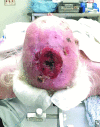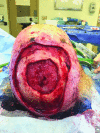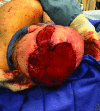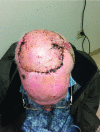Invasive Squamous Cell Carcinoma of the Scalp and Calvarium: A Multidisciplinary Approach
- PMID: 27909467
- PMCID: PMC5105116
Invasive Squamous Cell Carcinoma of the Scalp and Calvarium: A Multidisciplinary Approach
Abstract
Objective: The correlation between immunosuppression-associated skin cancer and lymphoma has been well established. This includes squamous cell carcinoma and chronic lymphocytic leukemia. When a lesion requires excision, reconstruction can be challenging based on the depth and size of the tumor. We present a patient with chronic lymphocytic leukemia and invasive squamous cell carcinoma of the scalp that extended through the calvarium to the dura mater. His tumors were badly neglected for a long period of time and presented at an advanced stage. Methods: This type of reconstruction was performed utilizing a multidisciplinary approach. Our patient required calvarial reconstruction with titanium mesh, dural reconstruction, latissimus dorsi free flap, and an overlying skin graft. Results: The patient had appropriate resection of his tumor while maintaining flap viability. Postoperatively, he presented with excellent soft-tissue thickness and aesthetic result. Conclusion: We believe that this type of reconstruction was best, considering our patient had a significant scalp and calvarial defect at presentation. Using a latissimus dorsi free flap bestows a robust blood supply to help decrease infections and improve healing and circulation, especially in light of the need of further radiation therapy.
Keywords: free flap reconstruction of the calvarium; latissimus dorsi free flap; microsurgical reconstruction; skull base reconstruction; squamous cell carcinoma and chronic lymphocytic leukemia.
Figures
References
Publication types
LinkOut - more resources
Full Text Sources




